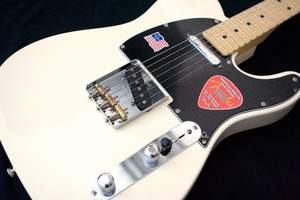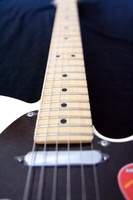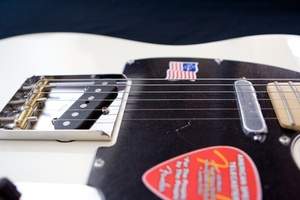What's left to say about the Telecaster? It's contribution to the world of popular music is without doubt. For those still in the dark, some of the music history's most memorable riffs were concocted on this divine piece of wood: "Brown Sugar" by the Rolling Stones "I'm a Man" by Muddy Waters, "Every Breath You Take" by the Police, and "Glory Days" by Bruce Springsteen...
Even if the overall Telecaster shape has not greatly evolved since its conception in 1949, Fender cleverly knew how to modernize its model to adapt to changing musical fashions. In addition, Fender needed to try to cope with, as best as possible, the burning needs of musicians who embraced technology. Consequently, it’s not that easy to figure out what’s available from Fender considering how many versions of this model there are. There is something for all tastes and all purse sizes! Between the Reissues, the Classic Series, the Custom, and Squiers, the Custom Shop Designed and so on, we find ourselves faced with a plethora of guitars with prices ranging from affordable to sick or even more in some cases …
A Body to Die For…
Unveiled for the first time at the 2010 NAMM show, and available to the public since January 2010, the “American Telecaster Special” is available in only two colors: “Olympic White” (the model to be tested) or “3 Color Sunburst”, both with a black three-ply plaque (black / white / black) and 8 nuts. The alder body has a contour based on the body shape of 1970s’ Telecasters. The gloss finish is urethane type. For those unfamiliar with the world of guitar craftsmanship, urethane finish is widely used now on most electric guitars. It is very thick and very resistant to shocks. Only problem, it does not leave much room for the wood to breathe. The color ”Olympic White" is reminiscent of the original color of the first Telecasters in the early 50s. Like all American Standard models, adjusting the neck with Truss Rod screwdriver will be at the head of the instrument in front of the saddle. Not aesthetically pleasing to my taste, but oh so handy!
The neck has a “C” profile with a pitch of 25.5 inches (648mm) and it has a radius of 9.5 inches (241 mm). One piece only, the neck is of solid maple wood without an attached fingerboard. 22 jumbo frets adorn the neck. Its finish, satin, is applied in very thin layers. Yes, comfort is optimal. While ordinarily I do not like this type of finish, I must confess that this finish’s soft attribute is very graceful. As a result, the hand glides and strokes the full length of the neck effortlessly. Dare I say that we found almost the sensation of nitrocellulose lacquer worn out by time and polished by the countless hand strokes while playing over the years. To see how it will age, and whether or not the neck finish remains velvety, only time will tell. The Fender motifs is of Fender Vintage Seventies style. The guitar is fitted with 009/042 string gauges, but deserved a 10–46 pulling power to purge out everything it has in its stomach. The “Fender Standard” mechanics play their part, but in any case I cannot guarantee a perfect pitch if you start to torture the guitar with the most diabolical “bends”!
A Beautiful Striptease

Gear-wise, the electronics’ mounting plate is chrome and of vintage type. The electronics consists of two controls, 250k solid shaft with “Dome” like buttons exactly like the Reissue Vintage and Classic Series Made in Mexico models. Regarding the controls, they are, like most Telecasters, reduced to a simple machine: a volume, tone and finally a position selector. After disassembling the plate controls and inspection of its innards, we see that the cavities are not shielded, but the welds are clean and tidy. There is no foul play with the knobs and a mass connected to the tone avoids any parasitic interference noise. The switch, is as always, vintage type with a 3 position blade: Position 1– Bridge Pickup, Position 2.-Bridge and Neck Pickups, and Position 3– Neck Pickup
The strings running down the body and the bridge are also of vintage type. A replica of the early 50s with the inscription "Fender Pat Bend”, the bridge has three adjustable brass saddles. If it lacks precision in its settings, it highlights well the snapping sound of the instrument, unlike the bridges with American Standard 6 saddles. Last default for this type of tailpiece, the guitar has a little less sustain. We are not going to nitpick any further, as you cannot have your cake and eat it too. At some point we must make compromises between what is practical and what is cool!
The Sonic Boom !
The pickups are two Texas Special™ Tele® Single-Coil (Alnico V). We can adjust the height of the pickups from the strings using the screws fixing the latter, both on the bridge pickup and on the neck pickup.
Upon first listen, one point emerges unequivocally positive: the pickups have an output level absolutely fabulous! After comparing them with their cousins “Highway one”, “American Standard” and “Classic Series” MADE IN MEXICO, the difference is glaring! From the standpoint of timbre, the pickups provide the reinforced midrange without neglecting the slamming treble attribute and the very punchy bass quality, both are characteristic of the Telecaster sound we love!
For testing purposes, the tone and volume on the guitar were respectively 10 and 10.
I was very surprised by the possibilities of position 1). If one easily recognizes the sound of the Telecaster, the tone is neither nasal nor harsh and less sharp, but rather has a certain roundness and sweetness with a strong character. This will allow it to blend easily into a lot of different musical styles, from rock to pop through the languid ballad rhythms ‘à la Aerosmith’…
The intermediate position in its clean sound, seemed to me a bit low on output level compared to the other two. One must move over to crunch sound in order to measure all its expressive capabilities that for sure will make your rhythmic funk jump!
The neck position, velvety and warm allows your rhythmic jazz sounds to shine bright. In its lead sound position, bluesmen will love it! Warning- your fingers will drip sweat of happiness!
Here are the sounds made with our amp The Valve 2 | 50–1 and our Two Notes Torpedo VB-101 .

- Manche Jazz00:17
- Manche Crunch00:10
- Intermediaire Funk00:14
- Arpege00:17
- Chevalet Sature00:21
- Chevalet Note00:16
- Chevalet Strumming00:18
- Chevalet Crunch 200:17
- Chevalet Crunch00:23
Conclusion
This new American Special Telecaster guitar today shares a lot of traits with its cousins “Highway One” models, “Reissue Classic”, and finally, the famous “American Standard Series” fer-de-lance catalog mark hailing from the city of Fullerton. Its ergonomics is simple, its finish clean, it is light weight with perfect mass load distribution. What else can we ask for with the price tag of $1099 for an instrument born and raised in the USA?
If you are looking for a Telecaster with a more “roots” sound in the same price range, move over to the more affordable Baja model, or the Classic Series models, both made in Mexico featuring pickups which offer more sonic dearth. If you opt more for a guitar with a less typical “retro” sound, then you’ve come to the right place.




